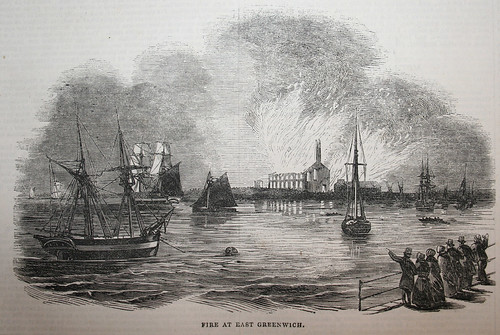Another snippet from my collection of the Illustrated London News – this time from 8th March 1845, detailing a conflagration that nearly destroyed a major factory in what we would probably today more commonly refer to as the Greenwich Peninsula.
The factory was owned by the grandsons of Samuel Enderby – who had created a whaling empire that at its height owned owned or leased 68 whaling ships.
After the death of their own father in 1829, two of the three grandsons, Charles and George Enderby brought the land by the Thames that was to become the site of the factory so disastrously afflicted by the fire that will be shortly described.
The grandsons were an unlucky duo as not only did their factory suffer serious damage, but their shrinking whaling fleet was also doing badly (for which modern readers may have less sympathy) and a decision to invest the insurance money in a setting up a settlement on Auckland Island in the South Pacific ultimately bankrupted the firm.
One whaling historian described the Enderbys as “Clogs to clogs in three generations”.
Endersby Wharf is still a landmark on the Greenwich Peninsula, close to the now-closed off section that houses a soon to be demolished starch and sugar factory.
Not only were the two grandsons failures in business, but the third grandson, Henry scandalised polite society by openly living with a male opera singer in West London. Shocking!
DESTRUCTIVE FIRE AT EAST GREENWICH
About eight o’clock, on Sunday evening, the extensive premises belonging to Messrs. Charles, Henry, and George Enderby, patent rope, twine, and canvass manufacturers, at East Greenwich, were discovered to be on fire. The flames were first observed from without, in the rope-walk at the rear of the factory, which was a strong brick building of about 140 feet long by 40 feet deep. It was not till day-break on Monday morning that the firemen could extinguish the flames, when a scene of the utmost desolation presented itself. Of the main factory, which faced the Thames, as was the most prominent object on that bank of the river between Greenwich Hospital and Woolwich, nothing remained but its lofty walls, which in the course of the day were blown down with tremendous force by the wind.
The machinery it contained was most extensive, and its immense value can be better judged from the fact that its completion has occupied a space of ten years. The whole of it was destroyed, It is proved that the flames were first seen raging in the store-room in the rope-manufactory, which was detached from the main building, where there had not been a light for several weeks.
There was a considerable quantity of manufactured goods deposited there, which were seen perfectly safe a few hours before the outbreak. The supposition is, therefore, that the fire either arose from spontaneous combustion, or was willfully caused by some incendiary. The factory, or waterside premises, containing joiners’ workshops, spinning, card, and loom rooms, is totally destroyed. The hemp and spinning-rooms over the engine and boiler-house are burned out, and the iron roof has fallen in. The engine-room beneath is considerably damaged. The weaving workshops, fronting the factory, are greatly damaged; the roof has been partly demolished by the falling of the opposite walls. They contained twelve weaving looms, worked by machinery, which are all damaged. The dwelling-house of Mr. Enderby, on the north side of the factory, is much damaged by fire, and most of the furniture and its contents destroyed.; as are also the stores at the back, and part of the rope manufactory. The rope gallery, adjoining the manufactory, is a quarter of a mile in length; about 100 feet is gone, and but for the firemen cutting off the communication, the whole would have been levelled to the ground. Unhappily, upwards of 250 workmen are thrown out of employment by this calamitous event.
The exertions made by the military, parochial, and other authorities, as well as by the neighbours and workpeople, during the conflagration, were very efficient in saving much valuable property. The loss to the worthy proprietors, we are happy to add, is well covered by insurances.








sounds like the brothers were no good at business but looks like they at least managed to pull off a decent insurance job 🙂
So much time has passed it may seem unnecessary to defend Enderby BUT….The comment clogs to clogs in three generations is a total calumny. They were of a wealthy business family that started well before 1650. They did eventually lose everything but that is another story. The works destroyed were a ten year project to as we would say diversify successfully from their core business, whaling, that had declined because of over-fishing and under investment (very modern !!). Their insurance did not cover them. In present day terms they lost close to £2 million. Their insurance was for only £250K
Oh and one more thing for now…Henry Enderby lived with his adopted son who was a singer and who later married. There is no proof but substantial indication that his son was given a home by Henry from very unfortunate circumstances. Most of the innacuracies of the Enderby history are sourced to the works of A G E Jones who had an almost curious dislike for them and never deeply studied them. If anyone can produce evidence of public scandal about Henry at the time I would be deeply grateful.